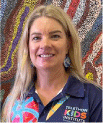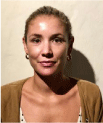Skin health in northern Australia
Hannah M. M. Thomas A * , Stephanie Enkel A B , Tracy McRae A B , Victoria Cox C D , Heather-Lynn Kessaris C , Abbey J. Ford A , Rebecca Famlonga A E , Rebekah Newton A F , Ingrid Amgarth-Duff A , Alexandra Whelan A and Asha C. Bowen A B GA Wesfarmers Centre of Vaccines and Infectious Diseases, Telethon Kids Institute, 15 Hospital Avenue, Nedlands, WA 6009, Australia.
B University of Western Australia, 35 Stirling Highway, Crawley, WA 6009, Australia.
C Royal Darwin Hospital, 105 Rocklands Drive, Tiwi, NT 0810, Australia.
D Menzies School of Health Research, John Matthew Building, Royal Darwin Hospital Campus, Rocklands Drive, Casuarina, NT 0810, Australia.
E Murdoch University, 90 South Street, Murdoch, WA 6150, Australia.
F Royal Perth Hospital, Victoria Square, Perth, WA 6000, Australia.
G Perth Children’s Hospital, 15 Hospital Avenue, Nedlands, WA 6009, Australia.

Dr Hannah M. M. Thomas is an early career postdoctoral researcher at the Wesfarmers Centre of Vaccines and Infectious Diseases, Telethon Kids Institute. Hannah’s research aims to reduce the burden of skin infections for children living in the remote Kimberley region of Western Australia through the implementation of a holistic package of clinical, preventative, and capacity-building skin health interventions. |

Stephanie Enkel is a PhD Candidate at the School of Medicine, University of Western Australia and the Wesfarmers Centre of Vaccines and Infectious Diseases, Telethon Kids Institute. Her research focuses on environmental health initiatives to halt the transmission of Streptococcus pyogenes infection in remote Australian Aboriginal and Torres Strait Islander communities. |

Tracy McRae is a PhD Candidate and Research Assistant at the Telethon Kids Institute. Her research focuses on prevention initiatives to help reduce the burden of skin infections in remote Aboriginal communities. Through this work, Tracy has been working with communities to embed local language into healthy skin resources. |

Dr Victoria Cox is a medical doctor at Royal Darwin Hospital and a PhD student at the Menzies School of Health Research with an interest in Neglected Tropical Diseases with skin manifestations. She undertook the MPhil in Evidence Based Social Intervention and Policy Evaluation at the University of Oxford as a General Sir John Monash Scholar between 2016 and 2018. Victoria is currently working on a collaborative project to estimate the burden of scabies in Indigenous communities and consider the impact of undertaking an ivermectin-based MDA treatment program in northern Australia. |

Dr Heather-Lynn Kessaris is an Alawa and Marra woman from the Northern Territory. She initially completed a Bachelor of Science at the University of Western Australia in 2014, majoring in Population Health and Aboriginal Health and Wellbeing, before going on to complete her Doctor of Medicine in 2018 in Perth, Western Australia. She is currently a resident medical officer based at the Royal Darwin Hospital and has a keen interest in dermatology. |

Abbey J. Ford is a Project Officer on the See, Treat, Prevent Skin Sores and Scabies (SToP) Trial. She works with East Kimberley Aboriginal communities to coordinate data collection visits and run health promotion projects, with the ultimate aim to decrease skin infections in remote communities. |

Rebecca Famlonga is an Aboriginal woman descending from the Wadawurrung people in Southwestern Victoria. She has more than 20 years of experience in Education and has held teaching and leadership positions in secondary schools across Western Australia. Rebecca is currently a Senior Research Officer at the Telethon Kids Institute and is completing her Masters by Research at Murdoch University. |

Dr Rebekah Newton is a Doctor of Medicine graduate from the University of Western Australia, and recipient of the Australian Medical Association WA Prize for 2021. She is an aspiring paediatrician, with a special interest in rural medicine and infectious diseases, and has worked on the SToP Trial to examine the relationship between head lice and impetigo. |

Dr Ingrid Amgarth-Duff is an early-career, postdoctoral researcher at the Telethon Kids Institute in Perth, Western Australia. She is leading the development of the 2nd Edition of the National Healthy Skin Guidelines, which has been developed for treating clinicians. The guidelines focus on the prevention and treatment of skin infections for Aboriginal populations living in remote areas of Australia. |

Alexandra Whelan is Program Manager for the ENDRHD Program at the Telethon Kids Institute, a team of researchers committed to ending Rheumatic Heart Disease (RHD) in Australia. Alexandra manages their portfolio of research, which aims to accelerate research, clinical trials, treatment methods, policy and advocacy; ultimately working to prevent diseases caused by Strep A, including skin infections, which contribute to the development of RHD. |

Associate Professor Asha C. Bowen is a clinician scientist working across the Perth Children’s Hospital as a paediatric infectious disease specialist and the Telethon Kids Institute as Head of the Healthy Skin and ARF Prevention Team and the ENDRHD Program. Asha and her team launched the inaugural National Healthy Skin Guidelines to guide clinicians in the recognition and evidence-based treatment of skin infections, and are updating this resource in 2022. Asha has more than 10 years’ experience leading infectious diseases research and investigator-initiated clinical trials focused on issues significant to Aboriginal child health. |
Microbiology Australia 43(3) 98-103 https://doi.org/10.1071/MA22033
Submitted: 15 June 2022 Accepted: 20 September 2022 Published: 10 October 2022
© 2022 The Author(s) (or their employer(s)). Published by CSIRO Publishing on behalf of the ASM. This is an open access article distributed under the Creative Commons Attribution-NonCommercial-NoDerivatives 4.0 International License (CC BY-NC-ND)
Abstract
Achieving healthy skin requires the prevention of infectious diseases that affect the skin. Prevention activities range from environmental health improvements to address inequities in living situations, through to community-wide treatment programs to reduce transmission and improve skin health. In this paper we discuss the pathogens that cause and conditions that arise when skin is infected, the burden of disease in northern Australia, and some of the current research underway to address this high burden, which predominantly affects remote-living Aboriginal and Torres Strait Islander children and families.
Keywords: Aboriginal and Torres Strait Islander populations, environmental health, health promotion, impetigo, infectious diseases, northern Australia, scabies, skin health.
References
[1] Currie, BJ and Carapetis, JR (2000) Skin infections and infestations in Aboriginal communities in northern Australia. Australas J Dermatol 41, 139–143.| Skin infections and infestations in Aboriginal communities in northern Australia.Crossref | GoogleScholarGoogle Scholar |
[2] Bowen, AC et al.. (2015) The global epidemiology of impetigo: a systematic review of the population prevalence of impetigo and pyoderma. PLoS One 10, e0136789.
| The global epidemiology of impetigo: a systematic review of the population prevalence of impetigo and pyoderma.Crossref | GoogleScholarGoogle Scholar |
[3] Davidson, L et al.. (2020) Skin infections in Australian Aboriginal children: a narrative review. Med J Aust 212, 231–237.
| Skin infections in Australian Aboriginal children: a narrative review.Crossref | GoogleScholarGoogle Scholar |
[4] Thomas, L et al.. (2019) Burden of skin disease in two remote primary healthcare centres in northern and central Australia. Intern Med J 49, 396–399.
| Burden of skin disease in two remote primary healthcare centres in northern and central Australia.Crossref | GoogleScholarGoogle Scholar |
[5] Wong, L-CF et al.. (2001) Outcome of an interventional program for scabies in an Indigenous community. Med J Aust 175, 367–370.
| Outcome of an interventional program for scabies in an Indigenous community.Crossref | GoogleScholarGoogle Scholar |
[6] Andrews, RM et al.. (2009) A regional initiative to reduce skin infections amongst Aboriginal children living in remote communities of the Northern Territory, Australia. PLoS Negl Trop Dis 3, e554.
| A regional initiative to reduce skin infections amongst Aboriginal children living in remote communities of the Northern Territory, Australia.Crossref | GoogleScholarGoogle Scholar |
[7] Francis, JR et al.. (2020) Hyperendemic rheumatic heart disease in a remote Australian town identified by echocardiographic screening. Med J Aust 213, 118–123.
| Hyperendemic rheumatic heart disease in a remote Australian town identified by echocardiographic screening.Crossref | GoogleScholarGoogle Scholar |
[8] Speers, DJ et al.. (2017) M protein gene (emm type) analysis of group A Streptococcus isolates recovered during an acute glomerulonephritis outbreak in northern Western Australia. Pathology 49, 765–769.
| M protein gene (emm type) analysis of group A Streptococcus isolates recovered during an acute glomerulonephritis outbreak in northern Western Australia.Crossref | GoogleScholarGoogle Scholar |
[9] Custodio, J et al.. (2016) Working in partnership with communities at risk: the potential of integrated public health action during an outbreak of APSGN in remote Australia. Aust Indig Health Bull 16, .
[10] Mullane, MJ et al.. (2019) SToP (See, Treat, Prevent) skin sores and scabies trial: study protocol for a cluster randomised, stepped-wedge trial for skin disease control in remote Western Australia. BMJ Open 9, e030635.
| SToP (See, Treat, Prevent) skin sores and scabies trial: study protocol for a cluster randomised, stepped-wedge trial for skin disease control in remote Western Australia.Crossref | GoogleScholarGoogle Scholar |
[11] Kris, E et al.. (2021) Breathing life into community-driven research in the Torres Strait. Med J Aust 215, 304–304.e1.
| Breathing life into community-driven research in the Torres Strait.Crossref | GoogleScholarGoogle Scholar |
[12] Bowen, AC et al.. (2014) The microbiology of impetigo in Indigenous children: associations between Streptococcus pyogenes, Staphylococcus aureus, scabies, and nasal carriage. BMC Infect Dis 14, 727.
| The microbiology of impetigo in Indigenous children: associations between Streptococcus pyogenes, Staphylococcus aureus, scabies, and nasal carriage.Crossref | GoogleScholarGoogle Scholar |
[13] Bowen, AC et al.. (2014) Short-course oral co-trimoxazole versus intramuscular benzathine benzylpenicillin for impetigo in a highly endemic region: an open-label, randomised, controlled, non-inferiority trial. Lancet 384, 2132–2140.
| Short-course oral co-trimoxazole versus intramuscular benzathine benzylpenicillin for impetigo in a highly endemic region: an open-label, randomised, controlled, non-inferiority trial.Crossref | GoogleScholarGoogle Scholar |
[14] Bowen, AC et al.. (2014) Standardising and assessing digital images for use in clinical trials: a practical, reproducible method that blinds the assessor to treatment allocation. PLoS One 9, e110395.
| Standardising and assessing digital images for use in clinical trials: a practical, reproducible method that blinds the assessor to treatment allocation.Crossref | GoogleScholarGoogle Scholar |
[15] Clucas, DB et al.. (2008) Disease burden and health-care clinic attendances for young children in remote Aboriginal communities of northern Australia. Bull World Health Organ 86, 275–281.
| Disease burden and health-care clinic attendances for young children in remote Aboriginal communities of northern Australia.Crossref | GoogleScholarGoogle Scholar |
[16] McMeniman, E et al.. (2011) Skin disease in the first two years of life in Aboriginal children in East Arnhem Land. Australas J Dermatol 52, 270–273.
| Skin disease in the first two years of life in Aboriginal children in East Arnhem Land.Crossref | GoogleScholarGoogle Scholar |
[17] Hendrickx, D et al.. (2018) Ascertaining infectious disease burden through primary care clinic attendance among young Aboriginal children living in four remote communities in Western Australia. PLoS One 13, e0203684.
| Ascertaining infectious disease burden through primary care clinic attendance among young Aboriginal children living in four remote communities in Western Australia.Crossref | GoogleScholarGoogle Scholar |
[18] Abdalla, T et al.. (2017) Hospital admissions for skin infections among Western Australian children and adolescents from 1996 to 2012. PLoS One 12, e0188803.
| Hospital admissions for skin infections among Western Australian children and adolescents from 1996 to 2012.Crossref | GoogleScholarGoogle Scholar |
[19] McDonald, M et al.. (2004) Acute rheumatic fever: a chink in the chain that links the heart to the throat? Lancet Infect Dis 4, 240–245.
| Acute rheumatic fever: a chink in the chain that links the heart to the throat?Crossref | GoogleScholarGoogle Scholar |
[20] Yeoh, DK et al.. (2017) Are scabies and impetigo “normalised”? A cross-sectional comparative study of hospitalised children in northern Australia assessing clinical recognition and treatment of skin infections. PLoS Negl Trop Dis 11, e0005726.
| Are scabies and impetigo “normalised”? A cross-sectional comparative study of hospitalised children in northern Australia assessing clinical recognition and treatment of skin infections.Crossref | GoogleScholarGoogle Scholar |
[21] Skull, SA et al.. (1999) Investigation of a cluster of Staphylococcus aureus invasive infection in the Top End of the Northern Territory. Aust NZ J Med 29, 66–72.
| Investigation of a cluster of Staphylococcus aureus invasive infection in the Top End of the Northern Territory.Crossref | GoogleScholarGoogle Scholar |
[22] Brischetto, A et al.. (2016) A retrospective case-series of children with bone and joint infection from Northern Australia. Medicine (Baltimore) 95, e2885.
| A retrospective case-series of children with bone and joint infection from Northern Australia.Crossref | GoogleScholarGoogle Scholar |
[23] Engelman, D et al.. (2014) Invasive Staphylococcus aureus infections in children in tropical northern Australia. J Pediatric Infect Dis Soc 3, 304–311.
| Invasive Staphylococcus aureus infections in children in tropical northern Australia.Crossref | GoogleScholarGoogle Scholar |
[24] Oliver, J et al.. (2021) Preceding group A streptococcus skin and throat infections are individually associated with acute rheumatic fever: evidence from New Zealand. BMJ Glob Health 6, e007038.
| Preceding group A streptococcus skin and throat infections are individually associated with acute rheumatic fever: evidence from New Zealand.Crossref | GoogleScholarGoogle Scholar |
[25] Romani, L et al.. (2015) Prevalence of scabies and impetigo worldwide: a systematic review. Lancet Infect Dis 15, 960–967.
| Prevalence of scabies and impetigo worldwide: a systematic review.Crossref | GoogleScholarGoogle Scholar |
[26] Wong, L-C et al.. (2002) Factors supporting sustainability of a community-based scabies control program. Australas J Dermatol 43, 274–277.
| Factors supporting sustainability of a community-based scabies control program.Crossref | GoogleScholarGoogle Scholar |
[27] Kearns, TM et al.. (2015) Impact of an ivermectin mass drug administration on scabies prevalence in a remote Australian Aboriginal community. PLoS Negl Trop Dis 9, e0004151.
| Impact of an ivermectin mass drug administration on scabies prevalence in a remote Australian Aboriginal community.Crossref | GoogleScholarGoogle Scholar |
[28] Australian Government Department of Health (2022) The Pharmaceutical Benefits Scheme. https://www.pbs.gov.au/pbs/home
[29] Lydeamore, MJ et al.. (2019) A biological model of scabies infection dynamics and treatment informs mass drug administration strategies to increase the likelihood of elimination. Math Biosci 309, 163–173.
| A biological model of scabies infection dynamics and treatment informs mass drug administration strategies to increase the likelihood of elimination.Crossref | GoogleScholarGoogle Scholar |
[30] The Australian Healthy Skin Consortium (2018) National Healthy Skin Guideline: for the Prevention, Treatment and Public Health Control of Impetigo, Scabies, Crusted Scabies and Tinea for Indigenous Populations and Communities in Australia. 1st edn, Telethon Kids Institute, Perth, Western Australia.
[31] Lokuge, B et al.. (2014) Crusted scabies in remote Australia, a new way forward: lessons and outcomes from the East Arnhem Scabies Control Program. Med J Aust 200, 644–648.
| Crusted scabies in remote Australia, a new way forward: lessons and outcomes from the East Arnhem Scabies Control Program.Crossref | GoogleScholarGoogle Scholar |
[32] Hasan, T et al.. (2020) Crusted scabies; a 2-year prospective study from the Northern Territory of Australia. PLoS Negl Trop Dis 14, e0008994.
| Crusted scabies; a 2-year prospective study from the Northern Territory of Australia.Crossref | GoogleScholarGoogle Scholar |
[33] OneDisease (2021) Annual report 2020–2021.
[34] Cafarchia, C et al.. (2006) Isolation of Microsporum canis from the hair coat of pet dogs and cats belonging to owners diagnosed with M. canis tinea corporis. Vet Dermatol 17, 327–331.
| Isolation of Microsporum canis from the hair coat of pet dogs and cats belonging to owners diagnosed with M. canis tinea corporis.Crossref | GoogleScholarGoogle Scholar |
[35] Nguyen, T et al.. (2020) Case report: scald burn to the scalp complicated by fungal kerion. Burns Open 4, 191–193.
| Case report: scald burn to the scalp complicated by fungal kerion.Crossref | GoogleScholarGoogle Scholar |
[36] Grieve, K et al.. (2007) A randomised, double-blind, comparative efficacy trial of three head lice treatment options: malathion, pyrethrins with piperonyl butoxide and MOOV Head Lice Solution. Aust Pharmacist 26, 738–743.
[37] Amanzougaghene, N et al.. (2020) Where are we with human lice? A review of the current state of knowledge. Front Cell Infect Microbiol 9, 474.
| Where are we with human lice? A review of the current state of knowledge.Crossref | GoogleScholarGoogle Scholar |
[38] Cook, S et al.. (2007) Headlice: a precursor to Group A Streptococcal infection in remote Indigenous children. Prim Intention Aust J Wound Manage 15, 181–184.
| Headlice: a precursor to Group A Streptococcal infection in remote Indigenous children.Crossref | GoogleScholarGoogle Scholar |
[39] Currie, MJ et al.. (2010) A pilot study of the use of oral ivermectin to treat head lice in primary school students in Australia. Pediatr Dermatol 27, 595–599.
| A pilot study of the use of oral ivermectin to treat head lice in primary school students in Australia.Crossref | GoogleScholarGoogle Scholar |
[40] Hempenstall, A et al.. (2019) Leprosy in Far North Queensland: almost gone, but not to be forgotten. Med J Aust 211, 182–183.
| Leprosy in Far North Queensland: almost gone, but not to be forgotten.Crossref | GoogleScholarGoogle Scholar |
[41] O’Brien, DP et al.. (2000) Nontuberculous mycobacterial disease in northern Australia: a case series and review of the literature. Clin Infect Dis 31, 958–967.
| Nontuberculous mycobacterial disease in northern Australia: a case series and review of the literature.Crossref | GoogleScholarGoogle Scholar |
[42] Carapetis, JR et al.. (1995) Skin sores in Aboriginal children. J Paediatr Child Health 31, 563.
| Skin sores in Aboriginal children.Crossref | GoogleScholarGoogle Scholar |
[43] Tsoi, SK et al.. (2021) Estimation of scabies prevalence using simplified criteria and mapping procedures in three Pacific and southeast Asian countries. BMC Public Health 21, 2060.
| Estimation of scabies prevalence using simplified criteria and mapping procedures in three Pacific and southeast Asian countries.Crossref | GoogleScholarGoogle Scholar |
[44] World Health Organization (2021) Environment, Climate Change and Health.
[45] United Nations General Assembly (2011) United Nations Declaration on the Rights of Indigenous Peoples.
[46] Healthabitat (2019) The Healthy Living Practices.
[47] McLoughlin, F et al.. (2022) Skin health situational analysis to inform skin disease control programs for the Kimberley. Med J Aust 217, 58.
| Skin health situational analysis to inform skin disease control programs for the Kimberley.Crossref | GoogleScholarGoogle Scholar |
[48] Thomas, S et al.. (2017) Reducing recurrence of bacterial skin infections in Aboriginal children in rural communities: new ways of thinking, new ways of working. Aust J Prim Health 23, 229–235.
| Reducing recurrence of bacterial skin infections in Aboriginal children in rural communities: new ways of thinking, new ways of working.Crossref | GoogleScholarGoogle Scholar |
[49] Brown, AD et al.. (2006) Uncovering the determinants of cardiovascular disease among Indigenous people. Ethn Health 11, 191–210.
| Uncovering the determinants of cardiovascular disease among Indigenous people.Crossref | GoogleScholarGoogle Scholar |
[50] Bond, C et al.. (2012) ‘It had to be my choice’ Indigenous smoking cessation and negotiations of risk, resistance and resilience. Health Risk Soc 14, 565–581.
| ‘It had to be my choice’ Indigenous smoking cessation and negotiations of risk, resistance and resilience.Crossref | GoogleScholarGoogle Scholar |
[51] Laird, P et al.. (2020) We won’t find what we don’t look for: identifying barriers and enablers of chronic wet cough in Aboriginal children. Respirology 25, 383–392.
| We won’t find what we don’t look for: identifying barriers and enablers of chronic wet cough in Aboriginal children.Crossref | GoogleScholarGoogle Scholar |
[52] Haynes, E et al.. (2019) Community-based participatory action research on rheumatic heart disease in an Australian Aboriginal homeland: evaluation of the ‘On track watch’ project. Eval Program Plann 74, 38–53.
| Community-based participatory action research on rheumatic heart disease in an Australian Aboriginal homeland: evaluation of the ‘On track watch’ project.Crossref | GoogleScholarGoogle Scholar |
[53] Shield, JM et al.. (2018) Cross-cultural, Aboriginal language, discovery education for health literacy and informed consent in a remote Aboriginal community in the Northern Territory, Australia. Trop Med Infect Dis 3, 15.
| Cross-cultural, Aboriginal language, discovery education for health literacy and informed consent in a remote Aboriginal community in the Northern Territory, Australia.Crossref | GoogleScholarGoogle Scholar |


